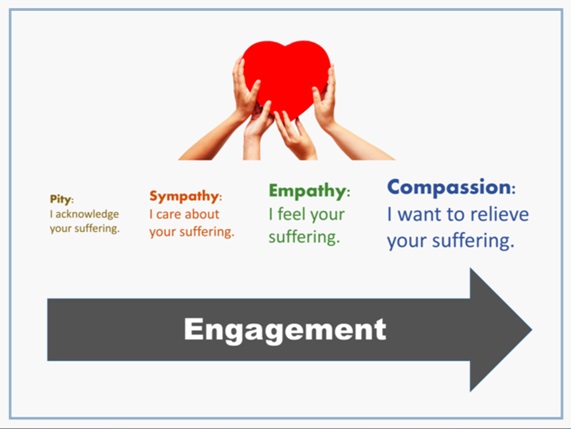by Marguerite Ham
I have often been asked “What is the difference between empathy & sympathy?” Although they are similar, they do have different meanings, especially when it comes to the workplace. Empathy is a great quality to develop to improve your leadership skills by building meaningful relationships with those you lead.
Empathy definition Webster
Empathy is defined as the ability to understand the thoughts feelings or emotions of someone else. An example of empathy is feeling the same amount of excitement as a friend, when they tell you they’re getting married.
Empathic: the psychological identification with the feelings, thoughts, or attitudes of others.
Sympathy Definition Webster
Sympathy is defined as feelings of pity and sorrow for someone else’s misfortune: an understanding between people; common feeling.
In general, ‘sympathy’ is when you understand and care about the feelings of another person; ’empathy’ is when you share those feelings. Sympathy means together, at the same time; a shared feeling of community and understanding of those feelings. Empathy emphasizes the notion of projection. You have empathy for a person when you can imagine how they might feel based on what you know about that person and share those feelings.
Empathy and Sympathy in the Workplace
As an example of the difference, we can feel sympathy for the suffering of animals without understanding exactly how they feel, but we can empathize with other human beings, even if we don’t feel like we have anything in common with them. We might despise an unscrupulous person and feel no sympathy when their house burns down, because we feel they got what they deserved – but we can still feel empathy because we can understand how it feels to lose a home and treasured posessions.
Empathy is a really important “way of being” to bring to your leadership in the workplace, it’s a habit we can cultivate to improve our lives personally and professionally. It’s the ability to “step into the shoes” of another person, aiming to understand their feelings and perspectives, and to use that understanding to guide our actions and interactions with others. We are wired for empathy, social cooperation and mutual aid. We can make empathy an attitude and a part of our daily lives. It is skill and way of being we can develop anytime.

So, how can I develop empathy? Here are 4 ways to develop empathy in the workplace:
1 Cultivate curiosity about others
Curiosity expands our empathy and world view. Ask open ended, meaningful questions of others. Be present, share in their joy about their experiences. Be curious about them and how they are feeling. Listen more, talk less! Seek to understand their perception about life/situations/experiences.
Workplace action step: Take time to “manage by walking around” and connect with your direct reports and co-workers. Ask them engaging questions and listen to understand their perspective. You may be surprised about what you learn!
2 Challenge your judgments, find commonalities
More often than not, when we don’t truly know someone, we create judgments about them. This hinders our empathy for others and our ability to lead, manage and coach effectively. Through conversation and asking questions, you can discover commonalities. You may just be surprised how much you have in common with someone you thought, “you did not like,” and/or thought, “you had nothing in common with.”
Workplace action step: Think about someone at work who you believe you have nothing in common with and may not care for. Find time to connect and engage in a conversation with them and ask them meaningful questions that would allow you to get to know them better. Example: “You always seem so organized, where did you learn that skill – any tips for me?” A very general, work related question; however, by giving a compliment and asking where they learned that skill and for tips, it brings down the walls and allows for the conversation to organically develop.
3 Step into their shoes

There is a Native American saying, “Walk a mile in another man’s moccasins before you criticize him.” It can be very easy to make a quick judgment about someone we just met. Slow down, take time to get to know the person. Remember they are a human being just like you with dreams, goals and challenges inside their hearts and heads.
Workplace action step: the next time you find yourself judging someone, slow down and reflect, shift yourself from judgment to understanding and start asking questions from step 1.
4 Listen deeply and be vulnerable
Artful and empathetic listening has to do with being present to what is really going on within another person – to their unique feelings and needs they may have in that very moment. Focus on grasping their emotional state and needs. Listening is great; however, taking it to the next level with vulnerability deepens the conversation. Removing our masks and revealing our feelings creates a strong, empathetic and mutual bond – an exchange of our most important beliefs and experiences.
Workplace action step: if you find yourself telling and directing more than listening, challenge yourself to listen 80% and talk 20%. If I want to focus on listening, I will actually put my hand over my mouth to remind myself not to talk! It actually works! You can also be vulnerable by sharing a personal story, that may be relevant to a conversation, share where you may have made a mistake, did something not so smart, and what you learned from that experience.
Resources
There is a lot of current research about the benefits of bringing empathy to the workplace. It lowers stress, creates more meaningful relationships and builds trust. I challenge you to energize your workplace with empathy by using the four steps listed in this article. Let me know how things are going and what shifts in your culture by being more empathetic. If you would like to know how empathetic you are, take this quiz: https://greatergood.berkeley.edu/quizzes/take_quiz/empathy
(*) This neat infographic was designed by Robert Shelton, a psychologist in a Californian high school, upon reading this article: https://www.psychologytoday.com/us/blog/hide-and-seek/201505/empathy-vs-sympathy Source: Robert Shelton


